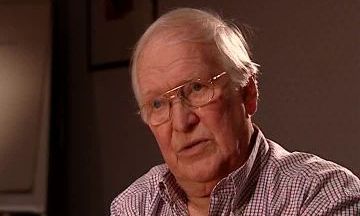NEXT STORY

Experimentally treating pancreatic cancer patients
RELATED STORIES

NEXT STORY

Experimentally treating pancreatic cancer patients
RELATED STORIES


|
Views | Duration | |
|---|---|---|---|
| 21. The gastrin story | 300 | 07:18 | |
| 22. Increasing incidences of oesophageal adenocarcinoma? | 94 | 06:12 | |
| 23. Working on a gastrin antagonist | 105 | 02:23 | |
| 24. Testing the effects of blocking gastrin on nude mice | 95 | 02:47 | |
| 25. Experimentally treating pancreatic cancer patients | 114 | 03:23 | |
| 26. Comparing our pancreatic cancer treatment with placebos | 110 | 05:22 | |
| 27. The beta blocking story | 1 | 129 | 06:55 |
| 28. Realising a new drug is needed for heart failure | 1 | 90 | 04:14 |
| 29. An innovative look at beta blockers | 99 | 04:37 | |
| 30. Inspiration from a Hammersmith Medicines Research report | 105 | 04:32 |


He remembered this experiment and it's called the Diels-Alder reaction, in which you take naphthalene – no, anthracene – and you interact it with a cyclised form of maleic acid. And what comes out of it is an extraordinary ring system called bicyclo-octanes, and this has got two ring system and two aromatics and you could functionalise the bridge between the two. And that was our lead, when we took these bicyclo-octanes very quickly we got into a... and in the standard way which we do the old fashioned chemistry: you make the compound, you test it, you learn from it, you make another one, and you iterate through it, and we iterated through it and we got better and better and better compounds. Now, one of the compounds we came to – a beauty, one of the best compounds I've ever worked with – it only had one problem and that was the liver couldn't distinguish it from a... a bile salt, and it was eliminated in the bile with the speed of light. And we could show that, in fact, it was absorbed extremely well, up the portal vein, but the liver was cleaning it out so that we'd get hardly any blood level, so the drug wouldn't act orally, but we could give it intravenously. Well, there wasn't much you could do with a drug you could only give intravenously. And then we read a paper by... that if you take nude mice – these are mice which have a suppressed immune system – so if you put a foreign protein in they don't react to them, so you can take cancer cell lines and embed them in these and... and they'll grow. Well, this particular cancer cell line was pancreatic cancer cells and so this group in Philadelphia showed that when these tumours were growing, if you gave them gastrin, they would go like mad. Anyway, so she tested our compound and showed that we could block that effect of gastrin and, indeed, we reduced the rate of growth of the tumour itself as though the mouse's own gastrin was stimulating the growth of it.
The late Scottish pharmacologist Sir James W Black (1924-2010) revolutionised medical treatment of hypertension and angina with his invention of propranolol, the first ever beta blocker. This and his synthesis of cimetidine, used for the treatment of peptic ulcers, earned him the Nobel Prize in Physiology or Medicine in 1988.
Title: Testing the effects of blocking gastrin on nude mice
Listeners: William Duncan
After graduating with a BSc Bill Duncan went on to gain a PhD from Edinburgh University in 1956. He joined the Pharmaceuticals Division of ICI where he contributed to the development of a number of drugs. In 1958, he started a collaboration with Jim Black working on beta blockers and left ICI with him in 1963 to join the Research Institute of Smith Kline & French as Head of Biochemistry. He collaborated closely with Black on the H2 antagonist programme and this work continued when, in 1968, Duncan was appointed the Director of the Research Institute. In 1979, he moved back to ICI as Deputy Chairman (Technical), a post he occupied until 1986 when he became Chairman and CEO of Coopers Animal Health. He ‘retired’ in 1989 but his retirement was short-lived and he held a number of directorships in venture capital backed companies. One of his part-time activities was membership of the Bioscience Advisory Board of Johnson and Johnson who asked him to become Chairman of the Pharmaceutical Research Institute of Johnson and Johnson in New Jersey. For personal reasons he returned to the UK in 1999, but was retained by Johnson and Johnson until 2006 in a number of senior position in R&D working from the UK. From 1999 to 2007 he was a non-executive director of the James Black Foundation. He is now fully retired.
Tags: Philadelphia
Duration: 2 minutes, 47 seconds
Date story recorded: August 2006
Date story went live: 02 June 2008